First, let’s discuss application methods and thickness of paint.
Because all these factors apply to the painting of your ceiling.
- Are you rolling paint on your ceiling:
Often, the DIY will use the roller application. Mostly because of the ease of use, the affordability and because it takes less time to prepare the room. - Here is where paint variable thickness comes into play.
There are many variables with paint viscosity that only a chemist could explain properly viscosity defines a fluid’s resistance to flow. Different textures and surfaces may require thicker or thinner paints. Flat surfaces will require a different thickness of paint than textures or popcorn. You’ll want to consult with your paint professionals or manufactures about this before beginning your project. Remember that gravity plays a big part here – you want your paint to be thick-to-stick and not drip. Adhesion is everything. - Will you use a Spray Gun to paint your ceiling?
A spray gun is faster and applies a thinner and more even coat of paint that dries faster. But prepping your room for spray takes much more time and requires placing and taping plastic over all walls, windows, and fixtures, so overspray paint does not get onto everything.
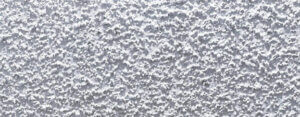 For popcorn ceilings, spraying is the best method to paint. Rolling cannot get paint into all the open pores and may pull the popcorn texture onto the roller.
For popcorn ceilings, spraying is the best method to paint. Rolling cannot get paint into all the open pores and may pull the popcorn texture onto the roller. - Time and Size of Project
Because of the room preparation time, a spray gun is mostly used in larger whole house or commercial projects, where it is more cost effective. Renting a paint sprayer is always an option. Or, if you are a seasoned DIY, or paint professional, you may have this sitting in your garage.
But for this article, let’s assume you are rolling your paint.
First let’s prepare your ceiling and remove any chips, cracks, or imperfections.
Just so you know: Not all paints will cover larger cracks, chips and peeling. This is why good preparation is important.
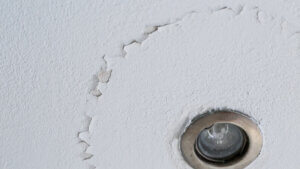
How do you repair cracks and peeling like a pro?
- Smaller hairline cracks can sometimes be covered with a “brushed-on” first coat of ceiling paint or primer, which is enough to fill the hairline. Then concealed with the final coat.
- For noticeable cracking and peeling, you can first sand and scrape away with a putty knife and smooth with sandpaper. Then apply a patching material, caulking, or sheet rock mud and texture if necessary.
- After that, you will brush-on a first coat of paint or primer, which will seal the patching compounds before painting.
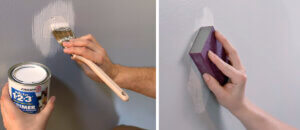
- Ask your paint professional. They are more familiar with all types of paint, they will know which paints will provide the right finish that goes well with the room.
- Ask the professionals:
Get the scoop and data sheet information on major brands like Benjamin-Moore, Kelly-Moore, Behr, and others to get the proper paint mix for your project.
What kind of paint should you use on your ceilings?
Ceilings should almost always be painted in a flat, matte acrylic paint. The reason for this is that flat paint will not reflect light or draw attention away from the wall and room furnishings.
Why should you use ceiling paint? What are the benefits?
There is no rule that says “Do Not” use wall paint on the ceiling. However, it is always a good idea to use the best paint for the job.
The type of ceiling you have will determine the paint thickness you use.
Some manufacturers make thicker products for textures and other applications.
Here are a few factors that make ceiling paint a better choice.
- Some ceiling paint is thicker and will adhere better without dripping. One coat of ceiling paint should be thick enough to cover the ceiling’s imperfections.
- Some manufacturers have developed a thinner paint just for acoustic ceiling tile, so the paint does not plug the holes.
- Some ceiling paints are formulated for easier application. Some manufacturers even produce paint in a different paint color, that turns white after they dry. Because of this, you can easily spot areas you might have missed.
- Again: Always check with your paint professional.
The professionals from El Gato Painting are adept at hiding imperfections in ceilings and walls. They apply 21-step preparation before starting to paint: from choosing the right type of paint to the tools needed, all to provide an excellent result. They can even provide you with professional tips for caring for your ceiling and making it last longer.
Why exert the effort of painting the ceiling all by yourself when you can get someone to take over the brush for you?
El Gato Painting has the knowledge, track record and reputation to do your project right. The first time.
Topics we will discuss with you before you hire us.
- We’ll furnish you our complete list of satisfied customers.
- Verify we are licensed and insured.
- Agree with you in writing on price and responsibilities.
- Be sure you get our best warranty for the work.
- Make sure we use high-quality materials and paints.
- We’ll carefully go over our 21 steps of preparation and application.
- Welcome your questions and concerns.
- Look forward to your final inspection of our crew’s excellent work.
Please visit our Certification pages:
– Google Page for our long list of 5 Star Ratings.
– El Gato Painting Services From our website here
– Reviews for the company Customer testimonials from our website here
This will give you the peace of mind that you have hired trustworthy and reliable professionals.
Contact El Gato Painting Services today and get a free quotation!
Click on Cat QR to PRINT
The El Gato Difference brochure

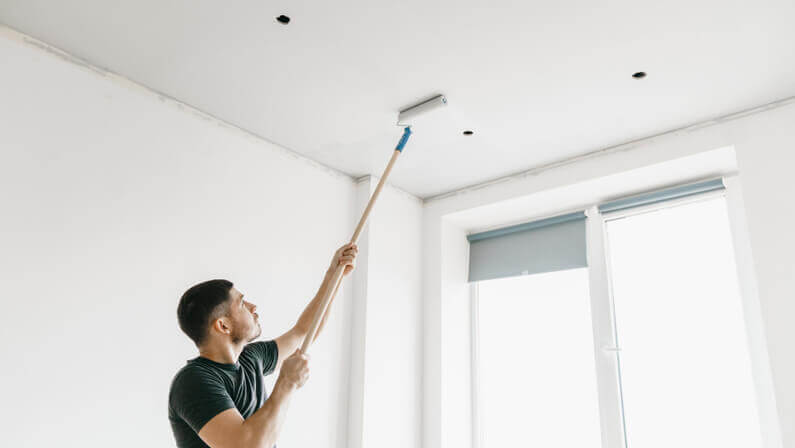

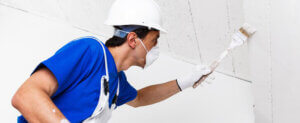







Comments are closed.